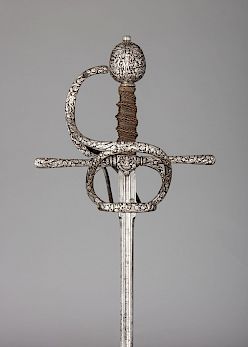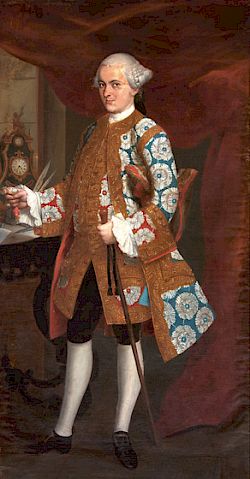Archival Reflections—Transatlantic Material Culture Research in Spain and the Americas
By Haley Schroer, PhD Candidate, The University of Texas at Austin
On June 21, 1604, Dr. Martos de Bohorquez, lawyer for the Inquisition in Mexico, demanded the seizure and arrest of Rodrigo Del Campo. Authorities often issued warrants like this against suspected heretics. However, Del Campo had not committed an offense against the Catholic faith but rather, had ridden a horse through Mexico City. A convicted Jew, Rodrigo faced a series of sumptuary regulations—statutes that restricted different groups from wearing certain garments or using particular items. Not only did the prohibitions prevent him from mounting a horse, but they also banned him from dressing in fine fabrics and sporting honorific objects like swords. Although Del Campo disappeared from Mexico before his sentencing, he resurfaced two years later in front of the Holy Tribunal of Seville. This time, witnesses condemned his use of silk garments and a decorative rapier. Despite the fact that this marked his second material offense in less than two years, Rodrigo maintained his ignorance of clothing prohibitions. Authorities appeared to believe the young man and let him off with a warning.

Transatlantic stories like that of Rodrigo Del Campo represent a common experience in the early modern Hispanic world. Rich nobles, poor travelers, law abiders, and criminals circulated the globe on a regular basis. Their pursuits between the Americas, Asia, and Europe left behind complex paper trails that crisscrossed oceans and continents. For the historians tasked with telling their tales, the investigative process is equally as international. Scholars like myself often find themselves employing both global methodologies and international flight schedules to tackle such projects.
Flitting between the Iberian Peninsula and the Americas, my personal journey relies on combining imperial perspectives. As a PhD candidate in colonial Latin American history, I focus on the relationship between race and material culture in the seventeenth century. In particular, my dissertation analyzes the rise of discriminatory clothing prohibitions in Mexico City, Lima, and Seville. By evaluating sumptuary regulations in each city, I determine how American legislation diverged from its peninsular counterparts. The comparative nature of my project thus demands that I employ a global perspective in my research. For example, I located Rodrigo’s first case in the General Archive of the Nation in Mexico City in the summer of 2016. Four years later, I encountered his second trial in the reading room of the National Historical Archive in Madrid. Without access to multiple national institutions, critical connections like that would be impossible to uncover.
Although my dissertation takes a transatlantic approach, the impetus for this topic originated in Texas. Throughout college and graduate school, I worked with a national clothing brand to help open new stores and assist the clientele. There I first witnessed the dynamic power of garments in everyday life. Males, females, adolescents, and adults sought to assert their individual identity through appearance. Customers relied on their outward presentation to promote personal traits, ethical values, and political preferences. Far from frivolous expenses, fashion had imbedded itself into the fabric of society.
I recognized this same relationship in the Spanish imperial world through my studies at both the undergraduate and graduate level. The colonization of the Americas created a level of diversity not seen before by European powers. Not only did Iberians intermix with native populations, but also with African slaves. As the viceroyalties became increasingly ethnically complex, authorities created a socio-racial hierarchy in an attempt to establish a sense of order. Given my professional background, I noticed the critical role that clothing—and the regulation of such items—played in the struggle to assert status in the public sphere.
The colonization of the Americas created a level of diversity not seen before by European powers. Not only did Iberians intermix with native populations, but also with African slaves. As the viceroyalties became increasingly ethnically complex, authorities created a socio-racial hierarchy in an attempt to establish a sense of order. Given my professional background, I noticed the critical role that clothing—and the regulation of such items—played in the struggle to assert status in the public sphere.
In order to understand further the relationship between attire, identity, and everyday life, I rely on a global approach in the archives. Spanish territories spanned continents. We cannot assume that daily culture looked the same across the board. Rather, historians must consider how geographical diversity allowed for autonomous customs. I thus evaluate documents held in both peninsular and American institutions to understand imperial and regional perspectives. How did individuals in the Americas engage with the monarch over material issues? How did clothing prohibitions engage with the broader legal sphere of the Spanish Empire? Documents housed in Latin American holdings can highlight the local particularities hidden in the imperial archives of Spain. By tailoring my methodology to the diversity of documents contained in different institutions, I recognize local particularities while highlighting overarching similarities.

In the process of connecting multiple archival perspectives, certain challenges arise. Differing levels of catalogues can present issues for scholars evaluating less concrete subjects. Although sumptuary legislation may be listed in legal registers, the inherently ephemeral nature of attire often results in searching unorganized boxes of documents hoping for individual complaints. References to clothing simultaneously can be everywhere and nowhere. Locating evidence thus relies on learning the structural quirks of the archive and adapting to the given classifications. When conducting global historical investigations, then, internal organizational systems exist as critical assets and encumbering impediments.
In addition to deciphering internal catalogues, global archival projects inevitably result in the deconstruction of complex paper trails. In my case, authorities and inhabitants of the Spanish Empire sent myriad letters, complaints, and petitions to numerous entities in the Americas and the Iberian Peninsula. As such, I must determine which authors wrote to which recipients for what reasons and where such papers now exist. Because I am conducting research in four to five archives across three continents, the decoding of this multidimensional communication system can be daunting. Scholars who focus on global perspectives thus must inherently work through documentational jigsaw puzzles to reveal clear analytical threads.
In spite of its potential challenges, global history is critical to connecting otherwise disjointed discourses. By combining the perspectives of various entities around the world, scholars can provide more nuanced discussions no matter the subject area or time period. Investigation into multiple archives provides insight into both critical differences and underlying similarities across humanity. With support from the Fulbright Program and the Social Science Research Council, I personally have been able to connect the stories of individuals oceans away from each other. Regardless of location, inhabitants in the Spanish Empire perceived clothing as an important marker of identity. Ultimately, utilizing a global lens allows researchers to interweave fully the transatlantic experiences of individuals like Rodrigo Del Campo into the broader historical narrative.
For further exploration of such topics, we invite you to visit the Metropolitan Museum's online exhibition "Interwoven Globe: The Worldwide Textile Trade, 1500–1800":